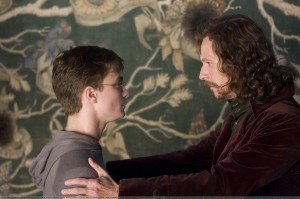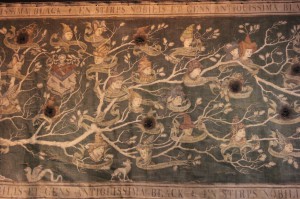
I’ll be blunt: J.K. Rowling is my favorite author. I’ve read (and reread) all of her books, watched her interviews (including an episode of Who Do You Think You Are?), and I follow her on Twitter and Facebook. She has entertained me for countless hours, allowing me to explore my imagination well beyond the socially acceptable limits for those in their adult years. I am always looking forward to the newest material from the mind of Ms. Rowling.
And while I love her creativity and passion for writing, I am often most impressed with her dedication to the authenticity of the story (even when it is a story about witches and wizards).
For example, when J.K. Rowling created her magical world, she did not limit character development to Harry Potter and his immediate friends and family. She thought about Harry Potter’s parents, grandparents, and his distant ancestors (including patriarch Salazar Slytherin). She thought about the relationships between these family members: How did they interact? Whom did they marry? What were the names of their children? How did the actions/characteristics of these individuals affect the life of Harry Potter? And she did this not only for the ancestors of Harry Potter, but also for the ancestors of Sirius Black (Harry Potter’s godfather) and Ron Weasley (Harry’s best friend).
In fact, during the filming of the fifth Harry Potter film, Order of the Phoenix, producer David Heyman contacted Rowling when a wall-sized family tree tapestry was required for a scene between Daniel Radcliffe (Harry Potter) and Gary Oldman (Sirius Black). Because all of the specifics of the Black family tree were not included in the book, Mr. Heyman hoped that Rowling would be able to provide a few additional names for aesthetic purposes: “In the book there are only a handful of names, but when you bring it to film, you actually have to visualize it, so I called Jo, and said ‘Jo, we need some more information, can you help us?’ Fifty minutes later she faxed down the Black family tree, which went back four or five generations and had seventy-five to a hundred names.”[1] From this, set designers created a full length tapestry showing some of the Black family names.
 Yet her dedication to the Potter, Black, and Weasley genealogies might lead one to think: Why would J.K. Rowling waste her time creating, organizing, and developing characters that would never be included in the seven novels or the eight movies in the series?
Yet her dedication to the Potter, Black, and Weasley genealogies might lead one to think: Why would J.K. Rowling waste her time creating, organizing, and developing characters that would never be included in the seven novels or the eight movies in the series?
First, for continuity: For epic novels, like Harry Potter or The Lord of the Rings, organized family trees help the author (and the reader) to follow the story line. Writing teachers even suggest using genealogical software when developing a novel, as it may deter mistakes in identity, age, or relationships.
But more importantly, for character development: Authors often develop their fictional characters through the relationships that they share with other people, whether parents, friends, siblings, or significant others. Yet J.K. Rowling takes the connection between her characters beyond the confines of the immediate family, and expands them to include ancestors from previous generations. For example, the tensions between the Weasley and Malfoy families (commonly seen throughout the seven Harry Potter books), began generations before the birth of Ron Weasley and Draco Malfoy.
So what does this have to do with genealogy? Well … just as J.K. Rowling created Harry Potter’s extended family in an effort to accurately tell his story, so too your own genealogical research demands similar treatment. Where and when were you born? Who were you named after? Do you have several veterans in your family? What nationality/ethnic group do you identify with? What is your religion or family tradition? For most, the influence of your family (both immediate and distant) will play a significant role in the way you answered the above questions. Therefore, if you wish to tell your story in the most accurate way, it is important to research and document those who have come before you. This will help to place you into the larger narrative of your own family history, and possibly explain some of your allegiances as well.
Note
[1] David Heyman, interview, special features, Harry Potter and the Order of the Phoenix. DVD. Warner Bros. Pictures, 2007.
Maybe that is one of the reasons that I found Rowland’s books to be a wonderful contribution to my reading-life. I could ‘picture’ the characters within the context of family and continuity !
What a fun post! I noticed the Black family tree tapestry as well, especially the bit where Sirius’ and Andromeda’s names were burnt out. A note, however, Slytherin was Voldemort’s ancestor, not Harry’s. The Potters descended from the Peverells, who “daughtered out” presumably.
Carol, you are correct! Harry is the direct descendant of Ignotus Peverell, the original possessor of the Cloak of Invisibility, through his father James Potter. Likewise, Tom Riddle (Voldemort) was a direct descendant of Cadmus Peverell, the original possessor of the Resurrection Stone. Therefore, because Tom Riddle was a descendant of Salazar Slythrin, Harry Potter and Salazar Slytherin were distant relatives.
My granddaughter read ever Harry Potter book and was intrigued by all. Now she has finally been one of the few members of my family to start being interested in family genealogy. Having a 2 year old daughter of her own now probably contributed to this interest.
My own family research over the last 30+ years has turned up several serendipitous discoveries. Thanks to my wife for helping me find out that my gr-gr-grandfather was buried in two different places!
Actually, he is buried in Arlington National Cemetery as he died of smallpox having been evacuated to a hospital in Washington, DC as the victim of a gunshot wound at the Battle of the Wilderness near Fredericksburg, VA in 1864. But, on a research trip to the Vermont State Archives my wife discovered a small file card stating he was buried in the Evergreen cemetery in the small town of New Haven, VT. Upon arrival that evening we started walking across the substantial cemetery for such a small town and suddenly looking to my left found me staring at a headstone for gr-gr-grandfather with a GAR marker next to it. And, not only that, but next to him was his wife and their heretofore unknown daughter, her husband and their four daughters!
It was later told to me that during the Civil War many memorial headstones were placed next to wife’s and other family members due to the problems encountered in transporting the deceased in those times or never being able to find their bodies after a confrontation.
I loved this post and I’m so glad you included a photo of the family tree. I think I replayed that scene 12 times on the DVD trying to get a good look at it!
What a delightful post. The connection to the work, joys and, yes, misery of genealogy virtually leapt off the page. Very inspirational. Thank you!
Bravo! Well done.
What a fun article! I, too, have read all the Potter books. On something of the same subject, I descend from Abraham Fulton and Margaret Guthrie who immigrated from Articlave, Londonderry, Northern Ireland to Westmoreland County, PA, in 1772. They are my fifth great-grandparents. Might we have a connection?
We may be distantly related, as my Fulton ancestors were from Magherafelt, Northern Ireland. However, my Fulton ancestors did not arrive in the States until 1885 (William Fulton and Ellen McCord). They settled in Lowell, Massachusetts.